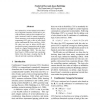Free Online Productivity Tools
i2Speak
i2Symbol
i2OCR
iTex2Img
iWeb2Print
iWeb2Shot
i2Type
iPdf2Split
iPdf2Merge
i2Bopomofo
i2Arabic
i2Style
i2Image
i2PDF
iLatex2Rtf
Sci2ools
90
Voted
ACL
2008
2008
A Logical Basis for the D Combinator and Normal Form in CCG
The standard set of rules defined in Combinatory Categorial Grammar (CCG) fails to provide satisfactory analyses for a number of syntactic structures found in natural languages. These structures can be analyzed elegantly by augmenting CCG with a class of rules based on the combinator D (Curry and Feys, 1958). We show two ways to derive the D rules: one based on unary composition and the other based on a logical characterization of CCG's rule base (Baldridge, 2002). We also show how Eisner's (1996) normal form constraints follow from this logic, ensuring that the D rules do not lead to spurious ambiguities.
ACL 2008 | CCG's Rule Base | Combinatory Categorial Grammar | Computational Linguistics | Satisfactory Analyses |
| Added | 29 Oct 2010 |
| Updated | 29 Oct 2010 |
| Type | Conference |
| Year | 2008 |
| Where | ACL |
| Authors | Frederick Hoyt, Jason Baldridge |
Comments (0)

